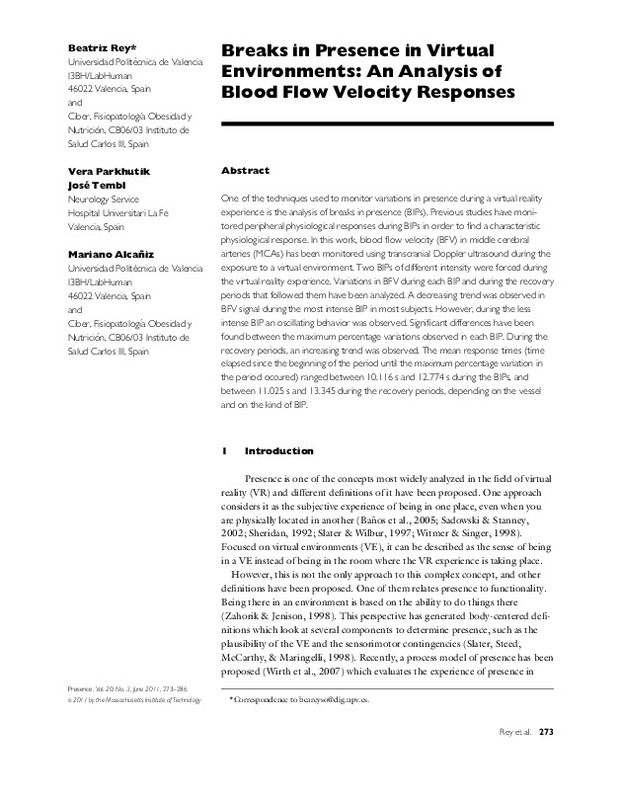JavaScript is disabled for your browser. Some features of this site may not work without it.
Buscar en RiuNet
Listar
Mi cuenta
Estadísticas
Ayuda RiuNet
Admin. UPV
Breaks in Presence in Virtual Environments: An Analysis of Blood Flow Velocity Responses
Mostrar el registro sencillo del ítem
Ficheros en el ítem
| dc.contributor.author | Rey Solaz, Beatriz
|
es_ES |
| dc.contributor.author | Parkhutik, Vera
|
es_ES |
| dc.contributor.author | Tembl, José
|
es_ES |
| dc.contributor.author | Alcañiz Raya, Mariano Luis
|
es_ES |
| dc.date.accessioned | 2017-03-22T08:15:58Z | |
| dc.date.available | 2017-03-22T08:15:58Z | |
| dc.date.issued | 2011-06 | |
| dc.identifier.issn | 1054-7460 | |
| dc.identifier.uri | http://hdl.handle.net/10251/78942 | |
| dc.description.abstract | One of the techniques used to monitor variations in presence during a virtual reality experience is the analysis of breaks in presence (BIPs). Previous studies have monitored peripheral physiological responses during BIPs in order to find a characteristic physiological response. In this work, blood flow velocity (BFV) in middle cerebral arteries (MCAs) has been monitored using transcranial Doppler ultrasound during the exposure to a virtual environment. Two BIPs of different intensity were forced during the virtual reality experience. Variations in BFV during each BIP and during the recovery periods that followed them have been analyzed. A decreasing trend was observed in BFV signal during the most intense BIP in most subjects. However, during the less intense BIP an oscillating behavior was observed. Significant differences have been found between the maximum percentage variations observed in each BIP. During the recovery periods, an increasing trend was observed. The mean response times (time elapsed since the beginning of the period until the maximum percentage variation in the period occured) ranged between 10.116 s and 12.774 s during the BIPs, and between 11.025 s and 13.345 during the recovery periods, depending on the vessel and on the kind of BIP. © 2011 by the Massachusetts Institute of Technology. | es_ES |
| dc.language | Inglés | es_ES |
| dc.publisher | Massachusetts Institute of Technology Press (MIT Press) | es_ES |
| dc.relation.ispartof | Presence: Teleoperators and Virtual Environments | es_ES |
| dc.rights | Reserva de todos los derechos | es_ES |
| dc.subject | Blood flow velocity | es_ES |
| dc.subject | Middle cerebral artery | es_ES |
| dc.subject | Oscillating behavior | es_ES |
| dc.subject | Physiological response | es_ES |
| dc.subject | Techniques used | es_ES |
| dc.subject | Transcranial Doppler ultrasound | es_ES |
| dc.subject | Virtual environments | es_ES |
| dc.subject | Virtual reality experiences | es_ES |
| dc.subject | Blood | es_ES |
| dc.subject | Flow velocity | es_ES |
| dc.subject | Hemodynamics | es_ES |
| dc.subject | Recovery | es_ES |
| dc.subject | Virtual reality | es_ES |
| dc.subject | Physiological models | es_ES |
| dc.subject.classification | EXPRESION GRAFICA EN LA INGENIERIA | es_ES |
| dc.title | Breaks in Presence in Virtual Environments: An Analysis of Blood Flow Velocity Responses | es_ES |
| dc.type | Artículo | es_ES |
| dc.identifier.doi | 10.1162/PRES_a_00049 | |
| dc.rights.accessRights | Abierto | es_ES |
| dc.contributor.affiliation | Universitat Politècnica de València. Escuela Técnica Superior de Ingeniería Agronómica y del Medio Natural - Escola Tècnica Superior d'Enginyeria Agronòmica i del Medi Natural | es_ES |
| dc.description.bibliographicCitation | Rey Solaz, B.; Parkhutik, V.; Tembl, J.; Alcañiz Raya, ML. (2011). Breaks in Presence in Virtual Environments: An Analysis of Blood Flow Velocity Responses. Presence: Teleoperators and Virtual Environments. 20(3):273-286. doi:10.1162/PRES_a_00049 | es_ES |
| dc.description.accrualMethod | S | es_ES |
| dc.relation.publisherversion | http://www.mitpressjournals.org/loi/pres | es_ES |
| dc.description.upvformatpinicio | 273 | es_ES |
| dc.description.upvformatpfin | 286 | es_ES |
| dc.type.version | info:eu-repo/semantics/publishedVersion | es_ES |
| dc.description.volume | 20 | es_ES |
| dc.description.issue | 3 | es_ES |
| dc.relation.senia | 193450 | es_ES |
| dc.identifier.eissn | 1531-3263 |








